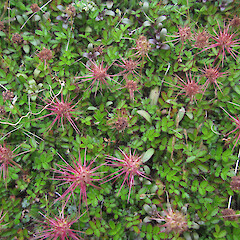Acaena microphylla var. pauciglochidiata
Family
Rosaceae
Flora category
Vascular – Native
Endemic taxon
Yes
Endemic genus
No
Endemic family
No
Structural class
Herbs - Dicotyledons other than Composites
NVS code
The National Vegetation Survey (NVS) Databank is a physical archive and electronic databank containing records of over 94,000 vegetation survey plots - including data from over 19,000 permanent plots. NVS maintains a standard set of species code abbreviations that correspond to standard scientific plant names from the Ngä Tipu o Aotearoa - New Zealand Plants database.
ACAMVP
Chromosome number
2n = c.42
Current conservation status
The conservation status of all known New Zealand vascular plant taxa at the rank of species and below were reassessed in 2017 using the New Zealand Threat Classification System (NZTCS) – more information about this can be found on the NZTCS website. This report includes a statistical summary and brief notes on changes since 2012 and replaces all previous NZTCS lists for vascular plants.
Please note, threat classifications are often suggested by authors when publications fall between NZTCS assessment periods – an interim threat classification status has not been assessed by the NZTCS panel.
- Conservation status of New Zealand indigenous vascular plants, 2017 . 2018. Peter J. de Lange, Jeremy R. Rolfe, John W. Barkla, Shannel P. Courtney, Paul D. Champion, Leon R. Perrie, Sarah M. Beadel, Kerry A. Ford, Ilse Breitwieser, Ines Schönberger, Rowan Hindmarsh-Walls, Peter B. Heenan and Kate Ladley. Department of Conservation. Source: NZTCS and licensed by DOC for reuse under the Creative Commons Attribution 4.0 International licence.
2017 | At Risk – Declining | Qualifiers: DP, RR, Sp
Previous conservation statuses
2012 | At Risk – Naturally Uncommon | Qualifiers: Sp
2009 | At Risk – Naturally Uncommon
2004 | Range Restricted
Distribution
South Island: Otago Peninsula, Southland coast; Stewart Island/Rakiura: between Ruggedy and Hellfire.
Habitat
Coastal gravel and sandy ground.
Detailed description
Rhizomatous perennial, mat-forming. Stems c. 1 mm diam., < 25 cm long, soon rooting and covered by soil; erect branchlets < 2 cm long. Leaves 0.5–3 cm long; stipules entire; leaflets 9–15, orbicular, 1.5–4 × 1.5–4 mm, with 5–7 obtuse teeth, green or bronze and shining on upper surface, with veins and teeth dark, glaucescent and sparsely hairy on lower surface. Capitulum ± sessile c. 5 mm diameter at flowering, < 3 cm diameter (including spines) at fruiting; florets c. 2–4; sepals 4; stamens 2; anthers white; styles 2, white. Fruit turbinate, c. 2 × 2 mm, glabrous; spines with a few stiff hairs at tip. Achenes 2.
Similar taxa
Distinguished from other Acaena species by its mat-forming growth and leaflets that are green or bronze above.
From Acaena microphylla var. microphylla it is distinguished by its fruiting heads hidden among leaves, 2–4 fruits with pale red spines bearing a few stiff hairs at tip or naked.
Etymology
acaena: From the Greek ‘akanthos’ thorn, referring to the spiny calyx that many species have
microphylla: Small leaf
pauciglochidiata: 'pauci' meaning few, 'glochidiata' meaning barbed, referring to the few barbs on the fruits of this variety.
Attribution
Fact sheet prepared by Marley Ford (13 December 2022). Brief description, Distribution, Habitat, Features, and Similar taxa sections copied from Webb et al. (1988).
References and further reading
Webb CJ, Sykes WR, Garnock-Jones PJ. 1988. Flora of New Zealand, Volume IV. Naturalised Pteridophytes, Gymnosperms, Dicotyledons. Botany Division, Department of Scientific and Industrial Research, Christchurch, NZ. 1365 p.












